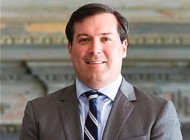
Sarah Ganz Blythe. Photo: Theresa Ganz.
After a 15-year tenure at Rhode Island School of Design (RISD), where she was most recently the deputy director for exhibitions, education and programs, Sarah Ganz Blythe is stepping into her new role as the director of Harvard Art Museums this month. Before these roles, she held positions at the Museum of Modern Art and the Metropolitan Museum of Art. Ganz Blythe earned a PhD in art history from the Institute of Fine Arts, New York University, where her studies focused on art and utopianism in Paris at the close of the Nineteenth Century. We caught up with her to discuss her latest accolades and future plans.
Congratulations on being named director of Harvard Art Museums! This isn’t your first time working with Harvard Art Museums, right?
Thank you, I am just thrilled to be a part of this incredible institution. Yes, as a student I interned in the conservation department. That experience revealed the profound rewards of engaging deeply with and thinking expansively about art.
What does a typical day look like for you?
It has just been four weeks since my arrival, so I haven’t quite hit typical yet. But each day has been devoted to getting to know a dynamic place. This includes learning about the work and ambitions of the remarkable staff and passionate supporters as well as meeting with students, faculty and campus partners for whom the museums play a crucial role. I am also connecting with the immediate community and arts institutions in the greater Cambridge and Boston area. My arrival has coincided with the start of the academic year, so like a new student, I am quickly getting oriented.
How do you plan to build upon the impressive work of your predecessor, Martha Tedeschi?
There are so many wonderful dimensions of Martha’s tenure that I look forward to building upon. For example, the significant expansion of the Harvard Art Museums’ reach since offering free admission marks an inflection point with compelling possibilities. By tripling attendance over the last two years, our institution is quickly operating at the scale and with the visitor expectations of a sizable civic museum while caring for an extraordinary collection and ambitiously realizing an academic museum’s learning and research goals. I find this space of public access and higher education timely and inspiring.

Harvard Art Museums at Night — evenings of art, fun, food and more — take place on the last Thursday of each month (holidays permitting). Photo: Caitlin Cunningham Photography.
You do hold teaching credentials and experience from RISD, Brown University and Wellesley College. Any plans to add teaching at Harvard to your résumé?
I always feel that teaching makes me better at my job. While I don’t have plans to teach, I am looking forward to learning from the many students who engage with our collections daily and contribute to the work of the museums in manifold ways.
Are there any curatorial plans you are personally looking forward to?
We are coming up on a decade since our three museums have been brought under one roof. During this period, our 50 collections galleries have been refreshed regularly with new acquisitions, smart interventions and rotations of light-sensitive material. But, overall, the narrative of those galleries has remained constant. Meanwhile, the collections are also remarkably active as objects are brought out of storage daily for learning in excitingly expansive ways in our Art Study Center. We have just begun reflecting on what we have learned over the past 10 years and are preparing for a new presentation of the collection.
How will working as the director of the Harvard Art Museums differ from previous positions you have held?
Every institution has its own cultures, responsibilities and possibilities that shape the work. This is the first institution I have worked in where there is no fee for admission. While this is just one barrier to entry, it sends a bold signal that the arts can be fundamental to daily life. I think that leaning into what this can mean will distinguish my work from the previous positions I have held.
While at RISD you were editor-in-chief of the museum’s periodical Manual. Do you plan to be involved in any publications with Harvard Art Museums?
Publications, whether digital or print, are an important way that museums can live outside their walls. They are also crucial spaces in which new research, critical reflection and multiple perspectives can take form and circulate. So, yes, I am very excited to be involved with the Harvard Art Museums’ robust publication program.
What future developments and contributions are you most excited about?
Works of art, whether made eons past or yesterday, continually invite new ways of seeing. I have found that my work is continuously fueled by returning to the object in community with others. I am compelled by how it acts in our present and connects us, the unknowns it holds that open paths for research and how it can inspire new creative outcomes. I am most excited to be embarking on this with such remarkable colleagues and seeing where it will lead us.
—Carly Timpson




